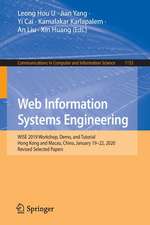Web and Big Data: 5th International Joint Conference, APWeb-WAIM 2021, Guangzhou, China, August 23–25, 2021, Proceedings, Part I: Lecture Notes in Computer Science, cartea 12858
Editat de Leong Hou U, Marc Spaniol, Yasushi Sakurai, Junying Chenen Limba Engleză Paperback – 19 aug 2021
| Toate formatele și edițiile | Preț | Express |
|---|---|---|
| Paperback (2) | 486.08 lei 6-8 săpt. | |
| Springer International Publishing – 19 aug 2021 | 486.08 lei 6-8 săpt. | |
| Springer International Publishing – 19 aug 2021 | 711.62 lei 6-8 săpt. |
Din seria Lecture Notes in Computer Science
- 20%
 Preț: 1061.55 lei
Preț: 1061.55 lei - 20%
 Preț: 307.71 lei
Preț: 307.71 lei - 20%
 Preț: 438.69 lei
Preț: 438.69 lei - 20%
 Preț: 579.30 lei
Preț: 579.30 lei -
 Preț: 410.88 lei
Preț: 410.88 lei - 17%
 Preț: 427.22 lei
Preț: 427.22 lei - 20%
 Preț: 596.46 lei
Preț: 596.46 lei - 15%
 Preț: 448.04 lei
Preț: 448.04 lei - 20%
 Preț: 353.50 lei
Preț: 353.50 lei -
 Preț: 389.49 lei
Preț: 389.49 lei - 20%
 Preț: 309.90 lei
Preț: 309.90 lei - 20%
 Preț: 645.28 lei
Preț: 645.28 lei - 20%
 Preț: 763.23 lei
Preț: 763.23 lei - 15%
 Preț: 580.46 lei
Preț: 580.46 lei - 20%
 Preț: 310.28 lei
Preț: 310.28 lei - 20%
 Preț: 655.02 lei
Preț: 655.02 lei - 20%
 Preț: 1183.14 lei
Preț: 1183.14 lei - 20%
 Preț: 340.32 lei
Preț: 340.32 lei -
 Preț: 449.57 lei
Preț: 449.57 lei - 20%
 Preț: 591.51 lei
Preț: 591.51 lei - 18%
 Preț: 938.83 lei
Preț: 938.83 lei - 20%
 Preț: 337.00 lei
Preț: 337.00 lei - 20%
 Preț: 649.50 lei
Preț: 649.50 lei - 20%
 Preț: 607.40 lei
Preț: 607.40 lei - 20%
 Preț: 1414.79 lei
Preț: 1414.79 lei - 20%
 Preț: 1024.44 lei
Preț: 1024.44 lei - 20%
 Preț: 583.40 lei
Preț: 583.40 lei - 20%
 Preț: 453.32 lei
Preț: 453.32 lei - 20%
 Preț: 575.49 lei
Preț: 575.49 lei - 20%
 Preț: 1075.26 lei
Preț: 1075.26 lei - 20%
 Preț: 585.88 lei
Preț: 585.88 lei - 20%
 Preț: 825.93 lei
Preț: 825.93 lei - 17%
 Preț: 360.20 lei
Preț: 360.20 lei - 20%
 Preț: 763.23 lei
Preț: 763.23 lei - 20%
 Preț: 340.32 lei
Preț: 340.32 lei - 20%
 Preț: 504.58 lei
Preț: 504.58 lei - 20%
 Preț: 369.13 lei
Preț: 369.13 lei - 20%
 Preț: 580.93 lei
Preț: 580.93 lei - 20%
 Preț: 343.62 lei
Preț: 343.62 lei - 20%
 Preț: 350.21 lei
Preț: 350.21 lei - 20%
 Preț: 583.40 lei
Preț: 583.40 lei - 20%
 Preț: 583.40 lei
Preț: 583.40 lei - 15%
 Preț: 438.59 lei
Preț: 438.59 lei - 20%
 Preț: 341.95 lei
Preț: 341.95 lei - 20%
 Preț: 238.01 lei
Preț: 238.01 lei - 20%
 Preț: 538.30 lei
Preț: 538.30 lei
Preț: 486.08 lei
Preț vechi: 607.59 lei
-20% Nou
Puncte Express: 729
Preț estimativ în valută:
93.02€ • 96.76$ • 76.80£
93.02€ • 96.76$ • 76.80£
Carte tipărită la comandă
Livrare economică 14-28 aprilie
Preluare comenzi: 021 569.72.76
Specificații
ISBN-13: 9783030858957
ISBN-10: 3030858952
Pagini: 498
Ilustrații: XXVI, 498 p. 223 illus., 162 illus. in color.
Dimensiuni: 155 x 235 mm
Greutate: 0.73 kg
Ediția:1st ed. 2021
Editura: Springer International Publishing
Colecția Springer
Seriile Lecture Notes in Computer Science, Information Systems and Applications, incl. Internet/Web, and HCI
Locul publicării:Cham, Switzerland
ISBN-10: 3030858952
Pagini: 498
Ilustrații: XXVI, 498 p. 223 illus., 162 illus. in color.
Dimensiuni: 155 x 235 mm
Greutate: 0.73 kg
Ediția:1st ed. 2021
Editura: Springer International Publishing
Colecția Springer
Seriile Lecture Notes in Computer Science, Information Systems and Applications, incl. Internet/Web, and HCI
Locul publicării:Cham, Switzerland
Cuprins
Graph Mining.- Co-Authorship Prediction Based on Temporal Graph Attention.- Degree-specific Topology Learning for Graph Convolutional Network.- Simplifying Graph Convolutional Networks as Matrix Factorization.- RASP: Graph Alignment through Spectral Signatures.- FANE: A Fusion-based Attributed Network Embedding Framework.- Data Mining.- What Have We Learned from Open Review? .- Unsafe Driving Behavior Prediction for Electric Vehicles.- Resource Trading with Hierarchical Game for Computing-Power Network Market.- Analyze and Evaluate Database-Backed Web Applications with WTool.- Semi-supervised Variational Multi-view Anomaly Detection.- A Graph Attention Network Model for GMV Forecast on Online Shopping Festival.- Suicide Ideation Detection on Social Media during COVID-19 via Adversarial and Multi-task Learning.- Data Management.- An Efficient Bucket Logging for Persistent Memory.- Data Poisoning Attacks on Crowdsourcing Learning.- Dynamic Environment Simulation for Database PerformanceEvaluation.- LinKV: an RDMA-enabled KVS for High Performance and Strict Consistency under Skew.- Cheetah: An Adaptive User-space Cache for Non-volatile Main Memory File Systems.- Topic Model and Language Model Learning.- Chinese Word Embedding Learning with Limited Data.- Sparse Biterm Topic Model for Short Texts.- EMBERT: A Pre-trained Language Model for Chinese Medical Text Mining.- Self-Supervised Learning for Semantic Sentence Matching with Dense Transformer Inference Network.- An Explainable Evaluation of Unsupervised Transfer Learning for Parallel Sentences Mining.- Text Analysis.- Leveraging Syntactic Dependency and Lexical Similarity for Neural Relation Extraction.- A Novel Capsule Aggregation Framework for Natural Language Inference.- Learning Modality-Invariant Features by Cross-Modality Adversarial Network for Visual Question Answering.- Difficulty-controllable Visual Question Generation.- Incorporating Typological Features into Language Selection for Multilingual Neural Machine Translation.- Removing Input Confounder for Translation Quality Estimation via a Causal Motivated Method.- Text Classification.- Learning Refined Features for Open-World Text Classification.- Emotion Classification of Text Based on BERT and Broad Learning System.- Improving Document-level Sentiment Classification with User-Product Gated Network.- Integrating RoBERTa Fine-Tuning and User Writing Styles for Authorship Attribution of Short Texts.- Dependency Graph Convolution and POS Tagging Transferring for Aspect-based Sentiment Classification.- Machine Learning.- DTWSSE: Data Augmentation with a Siamese Encoder for Time Series.- PT-LSTM: Extending LSTM for Efficient processing Time Attributes in Time Series Prediction.- Loss Attenuation for Time Series Prediction Respecting Categories of Values.- PFL-MoE: Personalized Federated Learning Based on Mixture of Experts.- A New Density Clustering Method using Mutual Nearest Neighbor.-





















